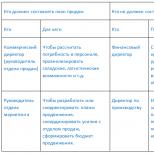What is a landing page? How to create a landing page?
It's no secret that one of the ways to fight for a client is advertising. It can have the most diverse manifestation, but the main goal will always be the same - the attention of the audience. Recently, the so-called landing pages have become widespread on the Internet, designed to attract users and turn them into buyers, customers, subscribers and other groups of customers loyal to the company or product. This type of online advertising is very effective and is often one of the main factors in gaining the trust of a large audience. In this article, we will go into detail about what a landing page is, how it works, and what you need to know to create a successful landing page.
Landing page: concept and reasons for creation
Surely you have come across this phenomenon more than once while surfing the Internet. Perhaps you simply did not know that you were dealing with a skillfully disguised advertising product. However, after reading the article, it will not be difficult for you to recognize it. So what is a landing page? The term comes from the English landing page and translates as "incoming / landing or selling page." It is a web page containing important information about a product or service and is used to increase the effectiveness of advertising and increase the audience. It is easy to get to it - through the banner of an Internet ad or a link in a search query. Often, the transition to the landing page is carried out from email newsletters, social media, as well as various advertising campaigns in search engines.
The reasons for creating a landing page are obvious. They can be roughly divided into three groups:
- encourage the user to subscribe to the newsletter or simply register on the site;
- push to download or install any software;
- sell a specific product in terms of a promotion, sale, etc.
If we summarize the reasons described above, then we can formulate the following purpose of the landing page: to turn an ordinary visitor into a buyer / subscriber and encourage him to take any specific action. I must say that the landing page copes with this perfectly.

Landing Page Classification: Kinds and Types
We figured out what a landing page is and why it is needed. However, it is important to know something else - how it looks. There are several options for creating a landing page.
landing page types
Let's look at the most popular types:
- main site;
- microsite;
- autonomous.
Some companies allocate several pages of their main site to create a landing page. Such an implementation has a place to be, but in most cases it is inefficient. This is due to the large number of navigation elements in the site design, which distract the user's attention from the advertising page.
More effective in this situation would be a separate microsite, consisting of three to five pages of an advertising nature. They contain, at a minimum, information about the product / service (only the most necessary), a lot of attractive pictures, video clips. The microsite is usually used for promotions by large companies.
The most popular type of landing page is the standalone landing page. It is also called CTR-landing. a detailed promotional offer, the main task of which is to encourage the user to take an action right now. The prefix Clickthrough rate means click through rate (the ratio of the number of people who went to the page through the banner to the number of its impressions). Its main attributes are a minimalist design, inviting slogans, an emphasis on the benefits of a real offer, large buttons, countdown timers. Such a page is considered the most effective method of attracting users.

Landing page types
There are also several main types of landing pages. This:
- viral;
- lead pages;
- advertising.
The viral landing page contains no explicit advertising. Here it is disguised as an article, video clip or game, while the company logo is usually located somewhere in the corner / side and "acts" unobtrusively. In this case, the effect is achieved by getting the user used to interactive entertainment, which as a result creates subconscious trust in the company/brand.
The lead page is used, as a rule, in the course of marketing research. It helps to collect information about the target user of a product/service through tools such as questionnaires. Then, based on the received data, an effective proposal is formed.
An advertising landing page is an aggressive form of influencing a visitor. It contains a large amount of graphic, textual information, video material. It is aimed at inciting to action through a powerful flow of informational influence.

Creating a Landing Page: Basic Rules
Before talking directly about creating a landing page, you need to understand what a landing page is from various points of view. There are at least three aspects to this:
- technical - a web page consisting of various elements (HTML, CSS, texts, graphics, video);
- business - a page that pushes the visitor to a specific action in order to obtain benefits (purchase/subscription);
- user - a page that he got to by a link from a search engine / another site / through a banner.
Considering all these aspects of the landing page, we can formulate the main criteria by which a good landing page can be built. And the first here is a call to action, or call to action. In order for it to work, you must follow the following rules:
- express clearly - clearly tell the user what he needs to do and what he will get as a result;
- limit the number of calls - the less there are, the faster the visitor will perform the desired action;
- have additional information in reserve - it eventually becomes a decisive factor for making a final decision;
- use buttons - they should be noticeable and encourage a click.
However, before seeing the call, the user must linger on the page. And for this you need to use the right headers. They must meet the following requirements:
- be simple and short;
- be attractive in terms of design (location, font);
- be capacious, contain relevant words.
It is also important that the page itself is pleasant and understandable to the user. To do this, it should be made as simple and convenient as possible, but attracting attention. What is important to follow:
- all elements of the landing page should encourage action;
- One landing page should have one main call to action.
- there should be a lot of "air" (free space) on the page itself;
- elements should be arranged in a clear logical sequence;
- graphic elements should be used to direct the gaze;
- it is desirable to separate parts of the page with contrasting colors.
In addition, there are a number of additional tricks that will make the page more efficient. What is a landing page, if not a motivator for immediate action? And to make it at the moment may be prompted by some kind of restriction - lack of time, product, etc. To create a sense of urgency, place countdown timers on the page until the end of discounts or a counter for the number of available goods.
Another important point is to convince the user of absolute safety and reliability when performing any action. To do this, place social data from authoritative web services on the page (for example, the number of likes on VK or Facebook), do not use fake reviews and statuses, and install trust elements next to calls to action.
By following these simple yet important tips, you will be able to create an effective landing page.

Conclusion
Advertising is the engine of any business. On the Internet, it takes on special forms and manifestations. In this article, we looked at what a landing page is and how it works for a business. We also learned about what it is like, what it includes, what rules you need to follow in order to create a good landing page. Use the suggested tips to create a landing page for developing your own business. Good luck!





